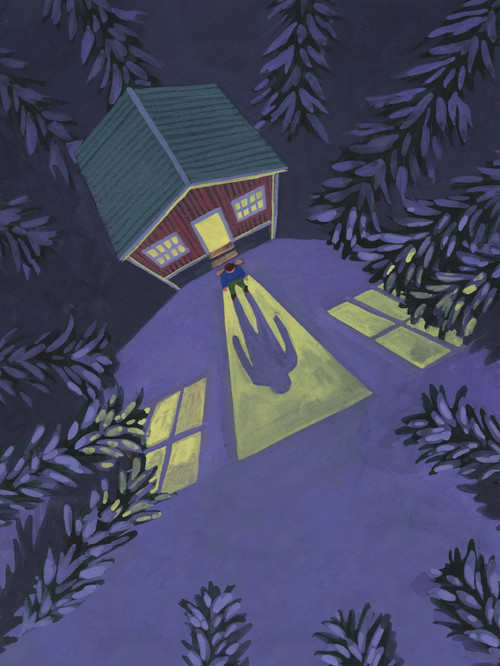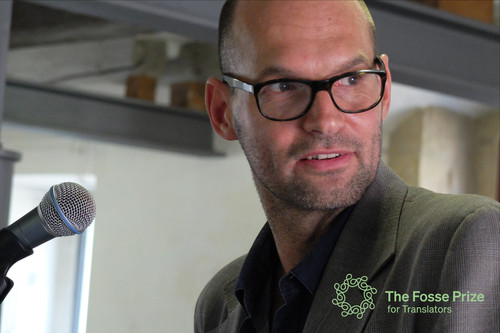Jon Fosse
Awarded The Nobel Prize in Literature 2023
Jon Fosse, born in 1959, is widely considered one of the most important writers of our time. For almost forty years he has written novels, plays, poems, stories, essays, and children’s books. His award-winning work has been translated into more than fifty languages, and his plays have been staged over a thousand times all over the world.
Fosse grew up on a small farm in Strandebarm in the Hardanger region of Norway. He went to high school in Øystese and studied literature at the University of Bergen. A full-time writer for most of his adult life, he has also worked as a journalist, taught at the Academy of Writing in Hordaland where one of his students was Karl Ove Knausgaard. He has also been a literary consultant, for instance for a retranslation of the Bible into Norwegian. In 2011, the Norwegian state awarded him its honorary artist’s residence for life, The Grotto, located in Slottsparken in Oslo, near the Royal Palace. Today, Fosse lives in Oslo, in Hainburg an der Donau, Austria, and in Frekhaug, near Bergen.
Fosse’s first novel, Raudt, svart (Red, Black), was published in 1983, but he considers a short story Han (He), published in a student newspaper in 1981, as his actual literary debut. Already there are many characteristic features of Fosse’s writing: repetition, inner monologue, and a musical, evocative style. Fosse continued to publish prose, poetry, and children’s books through the Eighties, but his breakthrough as an author came with the 1989 novel Naustet (Boathouse).
After having established himself as a novelist, poet, essayist, and children’s book writer, he also became a playwright. Despite having often expressed scepticism about the theatre, he wrote his first play in 1992, later describing this as the greatest revelation in his writing life. Nokon kjem til å kome (Someone Is Going to Come) is the first play Fosse wrote, although Og aldri skal vi skiljast (And Never Shall We Part) was the first to be performed, at the National Theater in Bergen in 1994.
Fosse wrote plays at a furious pace during these years, quickly appearing on the most important Norwegian stages, and after only a few years his plays were also being performed abroad. His international breakthrough came in 1999, when French director Claude Régy staged, Someone Is Going to Come in Nanterre outside Paris. The following year, the renowned Berlin theater Schaubühne put on Namnet (The Name) at the Salzburg Festival. These two productions helped pave the way for Fosse’s drama internationally.
Today, Jon Fosse’s plays have been performed all over the world. He has written more than thirty, including Namnet (The Name), Vinter (Winter), Ein sommars dag (A Summer’s Day), Draum om hausten (Dream of Autumn), Dødsvariasjonar (Death Variations), Svevn (Sleep), and Eg er vinden (I Am the Wind).
Although best known internationally as a playwright, Fosse has always written in other genres at an unusually high level. His novels include Melancholy I and Melancholy II, about the real Norwegian painter Lars Hertervig; Morning and Evening, about the birth of a child and the day of his death many decades later; and Trilogy, consisting of the three parts Andvake, Olavs draumar, and Kveldsvævd (Wakefulness, Olav’s Dreams, Weariness). It is a beautiful and disturbing story about a fiddler, Asle, and his girlfriend, Alida, for which Fosse won the Nordic Council’s Literature Prize in 2015.
In addition to his own writing, Jon Fosse has also reviewed literature and translated many works into New Norwegian, both prose and creating his own new versions of a number of plays.
Fosse’s longest work to date is Septology (2019–21), which he started during a break from playwrighting and after converting to Catholicism in 2013. Fosse has called his method of writing Septology ”slow prose”: a style of shifting levels, scenes, and reflections, the exact opposite of fast-paced drama. Its seven parts have been published in three volumes: The Other Name, I Is Another, and A New Name. It is a suggestive, magnificent narrative about the nature of art and God, about alcoholism, friendship, love, and the passage of time. Septology is translated into over 20 languages and is critically acclaimed worldwide.
For Septology, Jon Fosse has received numerous awards, including the Brage Prize and the Critics’ Prize. He has also been shortlisted for the international Booker Prize and the American National Book Award.
Furthermore, the hiatus in playwriting is over; Fosse is once again writing for the theater. Since 2020, three new plays have premiered. Jon Fosse’s most recent prose work, the novel Kvitleik (A Shining) was released in spring 2023 — a luminous narrative exploring the boundary between life and death.
In 2023, Jon Fosse is the winner of The Nobel Prize in Literature and is also celebrating a literary milestone, marking 40 years since his debut with the novel Raudt, svart (Red, black).
Collected prose by Jon Fosse
Raudt, svart (1983) – Red, Black
Stengd gitar (1985) – Closed Guitar
Blod. Steinen er (1987) – Blood. The Stone Is
Frå telling via showing til writing (1989) – From Telling via Showing to Writing
Uendelig Seint (1989) – Very, Very Slowly
Naustet (1989) – The Boathouse
Kant (1990)
Flaskesamlaren (1991) – The Bottle Collector
Bly og vatn (1992) – Lead and Water
Dyrehagen Hardanger (1993) – The Hardanger Zoo
To forteljingar (1993) – Two Stories
Prosa frå ein oppvekst (1994) – Scenes from a Childhood
Vått og svart (1994) – Dark and Wet
Melancholia I (1995) – Melancholy I
Nei å nei (1995) – No oh no
Du å du (1996) – My oh my
Fy å fy (1997) – Dear oh dear
Melancholia II (1996) – Melancholy II
Eldre kortare prosa med 7 bilete av Camilla Wærenskjold (1998) – Older Shorter Prose with 7 Images of Camilla Wærenskjold
Gnostiske essay (1999) – Gnostic Essays
Morgon og kveld (2000) – morning and Evening
Det er Ales (2004) – Aliss at the Fire
Andvake (2007) – Wakefulness
Spelejenta (2009) – The Fiddler Girl
Kortare prosa (2011) – Shorter Prose
Olavs draumar (2012) – Olav’s Dreams
Kveldsvævd (2014) – Weariness
Trilogien (2014) – Trilogy
Levande stein (2015) – Living Stones
Når ein engel går gjennom scenen og andre essay (2014) – An Angel Walks Through the Stage: and Other Essays
Det andre namnet – Septologien I-II (2019) – The Other Name: Septology I-II
Eg er ein annan – Septologien III-V (2020) – I Is Another: Septology III-V
Eit nytt namn – Septologien VI-VII (2021) – A New Name: Septology VI-VII
Septologien (2022) – Septology
Kvitleik (2023) – A Shining
Collected theatre by Jon Fosse
Og aldri skal vi skiljast (1994) – And We’ll Never Be Parter
Namnet (1995, 1998, 2008) – The Name
Nokon kjem til å kome (1996, 2004, 2018) – Someone is Going to Come
Barnet / Mor og barn / Sonen (1997) – The Child / Mother and Child / The Son
Gitarmannen (1997) – The Guitar Man
Natta syng sine songar / Ein sommars dag (1998) – Nightsongs / A Summer’s Day
Draum om hausten (1999, 2016) – Dream of Autumn
Besøk / Vinter / Ettermiddag (2000) – Visits / Winter / Afternoon
Vakkert (2001) – Beautiful
Dødsvariasjonar (2002) – Death Variations
Jenta i sofaen (2003) – The Girl in the Sofa
Lilla / Suzannah (2004)
Dei døde hundane / Sa ka la (2005) – The Dead Dogs / Sa ka la
Svevn / Varmt (2006) – Sleep / Warm
Rambuku / Skuggar (2007) – Rambuku / Shadows
Eg er vinden (2008) – I Am the Wind
Desse auga (2009) – These Eyes
Jente i gul regnjakke (2010) – Girl in Yellow Raincoat
Kortare stykke (2011) – Shorter Plays
Hav (2014) – Sea
Tre librettoar (2015) – Three Librettos
Slik var det (2020) – How It Was
Sterk vind. Eit scenisk dikt (2021) – Strong Wind
I svarte skogen inne (2023) – In a Dark Forest
Einkvan (2024)





